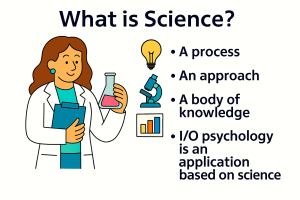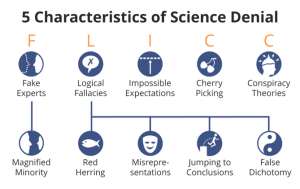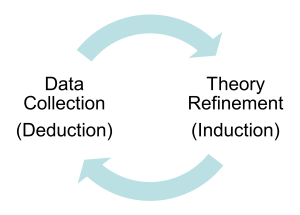2-1: What is Science?
 Your boss announces that the company is spending $50,000 on a new “revolutionary” team-building program because the CEO read about it in a business magazine. Meanwhile, your department is struggling with actual problems — unclear goals, poor communication, and outdated technology. Sound familiar?
Your boss announces that the company is spending $50,000 on a new “revolutionary” team-building program because the CEO read about it in a business magazine. Meanwhile, your department is struggling with actual problems — unclear goals, poor communication, and outdated technology. Sound familiar?
This scenario perfectly illustrates why research methods matter. They’re what separate evidence-based solutions from expensive mistakes disguised as innovation. You know how every few years there’s a new workplace trend that promises to solve everything? Open offices, forced fun, endless team retreats, hot-desking, mandatory meditation apps — most of these fads would never survive rigorous testing.
Here’s what makes this fascinating: organizations are incredibly messy, complex environments where human psychology intersects with business goals, technology, office politics, and countless other variables. You can’t just assume that what worked at Apple will work at your local nonprofit, or that a training program that boosted productivity in Germany will have the same effect in Brazil. That’s where sophisticated research methods come in — they help us navigate this complexity while maintaining scientific rigor.

Think of research methods as your BS detector for the workplace. They’re the tools that help you ask the right questions when someone presents the latest “game-changing” management strategy. What’s their evidence? How big was their sample? Did they control for other variables? Can these results actually apply to our situation?
The cool thing about modern I/O psychology research is how diverse our toolkit has become. We’re not stuck with just surveys and laboratory experiments anymore. Today’s researchers might analyze massive datasets from employee badges that track collaboration patterns, use smartphone apps to capture real-time mood and productivity data throughout the workday, or conduct virtual reality experiments to test leadership scenarios. It’s like having a Swiss Army knife for understanding workplace behavior.
But here’s why this matters to you personally: whether you end up conducting research yourself or just consuming it as a practitioner, understanding these methods will make you incredibly valuable in any organization. You’ll be the person who can look at a flashy consultant’s presentation and ask the penetrating questions that expose weak methodology. You’ll recognize when correlations are being sold as causation, when sample sizes are too small to mean anything, or when results from one context are being inappropriately generalized to yours.
Trust me, this kind of critical thinking will set you apart in your career. While others are getting swept up in the latest management fad, you’ll be the voice of reason asking for evidence. And when real solutions emerge from solid research, you’ll be able to recognize and champion them.
The Nature of Science in I/O Psychology
Let’s start with a fundamental question that might seem obvious but really isn’t: what makes something “scientific”? Science is a systematic discipline that builds and organizes knowledge in the form of testable hypotheses and predictions about the universe (Heilbron et al., 2003). It isn’t just a collection of facts that smart people have accumulated over time — it’s a systematic process for generating a reliable body of knowledge. Modern science is typically divided into two or three major branches: the natural sciences (e.g., physics, chemistry, and biology), which study the physical world; and the social sciences (e.g., economics, psychology, and sociology), which study individuals and societies (Cohen, 2021). It’s both a logic of inquiry (a way of doing things) and a way of knowing things that combines empiricism with rationalism.
New knowledge in science is advanced by research from scientists who are motivated by curiosity about the world and a desire to solve problems (MacRitchie, 2011). Contemporary scientific research is highly collaborative and is usually done by teams in academic and research institutions, government agencies, and companies. Mathematics is essential in the formation of hypotheses, theories, and laws, because it is used extensively in quantitative modeling, observing, and collecting measurements. You might be thinking, “Come on, how hard can it be to figure out what works in the workplace?” Actually, it’s trickier than you’d expect. Our intuitions about human behavior are often wrong, our memories are selective, and we’re prone to seeing patterns that don’t really exist. Plus, workplace behavior is influenced by so many factors that it’s easy to mistake correlation for causation or to generalize from small, unrepresentative samples.
Here’s something important to understand: scientists usually don’t care about individual cases, but instead focus on general rules and patterns (di Francia, 1976). It’s not the behavior of any one individual that matters for building theories — it’s the “average” behavior across many people that helps us understand underlying principles. This doesn’t mean individuals don’t matter, but rather that science seeks universal patterns that can help us understand and predict behavior more broadly.
Goals of Science
Think of science as having four main goals that work together like a GPS system for understanding workplace behavior. Each goal builds on the previous ones, creating increasingly powerful insights about how organizations really function.
Description
Description — painting an accurate portrayal of what’s actually happening in organizations. This might seem obvious, but you’d be amazed how often our assumptions about workplace behavior turn out to be completely wrong. For example, most people assume that money is the primary motivator for all employees, but descriptive research reveals a much more complex picture involving autonomy, purpose, social connection, recognition, and growth opportunities. Without accurate description, we’re building theories on quicksand.
Explanation
Explanation takes us deeper by asking “why” questions and helping us better understand phenomena. It’s not enough to know that some teams perform better than others — we want to understand the underlying mechanisms that create these differences. Maybe it’s because of better communication patterns, clearer role definitions, more effective conflict resolution, stronger psychological safety, or better leadership. Explanatory research helps us identify these causal factors so we can understand the machinery behind workplace success.
Prediction
Prediction is where things get really practical for organizations. If we understand relationships between variables, we can anticipate the occurrence of future events with reasonable confidence. This capability is invaluable for everything from hiring decisions to predicting which employees might leave the company, identifying teams at risk of conflict, or forecasting the likely success of organizational changes.
Here’s something interesting: prediction doesn’t always require full understanding. Netflix can predict what movies you’ll like without understanding the deep psychology of your preferences — they just need patterns in viewing behavior. Similarly, we might be able to predict job performance without fully understanding all the psychological mechanisms involved.
Control
Control represents the ultimate goal: being able to manipulate variables to affect behavior and influence outcomes through deliberate interventions. Once we understand what causes high performance, job satisfaction, effective leadership, or successful organizational change, we can design training programs, policy changes, or structural modifications to achieve desired results. This is where science becomes engineering — using knowledge to build better organizations.
Assumptions of Science
Now, you might be thinking, “This all sounds great in theory, but people aren’t laboratory rats — human behavior is way too unpredictable and complex for this scientific approach to work!” That criticism brings us to the assumptions of science that make this whole enterprise possible.
Empiricism
Empiricism assumes that the best way to understand behavior is to generate theories and then test them with actual data through systematic observation. This might seem obvious, but many workplace practices are based on what “feels right” to managers rather than what the evidence shows actually works. Empiricism says, “Show me the data” — and it’s surprising how often the data tells a different story than conventional wisdom.
Determinism
Determinism assumes that behavior is orderly and systematic, that individual behavior doesn’t happen by chance alone. This doesn’t mean people are robots or that free will doesn’t exist, but it does assume that behavior follows discoverable patterns and principles. Yes, individuals vary enormously and situations matter tremendously, but there are underlying regularities that we can identify and use to make predictions. This assumption implies a lack of complete free will in the sense that our behaviors are influenced by identifiable factors.
Discoverability
Discoverability is the optimistic assumption that it’s possible to discover the orderliness in behavior — that human ingenuity and good methodology can reveal behavioral patterns, even when they’re not immediately obvious. In theory, this means every behavior is potentially predictable if we understand enough about the relevant factors. There’s no magic involved — just systematic investigation of cause-and-effect relationships.
Theories in Science
Theories serve as our roadmaps in this scientific journey. A theory is a set of interrelated concepts and propositions that present a systematic view of phenomena. It’s not just a wild guess or someone’s opinion — it’s essentially a “best guess about a universal truth” based on available evidence and logical reasoning. The purpose of theories is to describe, explain, and predict, so theories directly further the goals of science.
Here’s something that might surprise you: according to philosopher Karl Popper (1959), science is fundamentally about theory-building, and the highest status any theory can achieve is “not yet disconfirmed.” This means you can’t really “prove” anything in science — you can only build evidence that supports theories or find evidence that shows they’re wrong. The implication? “Ya can’t prove nothin’!” This might sound discouraging, but it’s actually what makes science so powerful and self-correcting.
Characteristics of Good Theories
What makes a good theory? First, parsimony — simpler explanations are preferred when they account for the data just as well as complex ones. Einstein captured this principle perfectly: “Everything should be made as simple as possible, but not simpler.” We want theories that are elegant and economical, not unnecessarily complicated.
Precision means theories should make specific, testable predictions rather than vague statements that could mean anything. Testability is crucial — if a theory can’t be tested through research, it might be interesting philosophy, but it’s not useful science (Popper, 2002). Usefulness means theories should inform practical applications, not just satisfy intellectual curiosity. Finally, generativity refers to theories’ ability to inspire new research questions and discoveries, opening up new avenues for investigation.
The Cyclical Inductive-Deductive Model of Research
This brings us to a classic question: which comes first, the chicken or the egg? In science terms: do we start with data or theory?

Induction is an approach to science that consists of working from data to theory — starting with observations and building toward theoretical explanations. Deduction starts with theory and then collects data to test theoretical predictions. Good scientists use both approaches in what’s called the cyclical inductive-deductive model of research. You might start with observations that suggest a theory, derive specific predictions from that theory, test those predictions through research, and then modify your theory based on the results. This cycle gradually improves our understanding while keeping us grounded in evidence.
Media Attributions
- What is Science? © Jay Brown and Copilot
- Characteristics of Science Denial © Gregor Hagedorn is licensed under a CC BY-SA (Attribution ShareAlike) license
- Data and Theory Feed Each Other © Jay Brown
